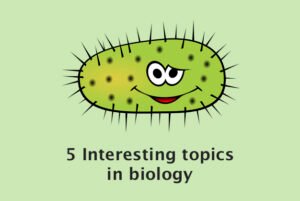5 Interesting Topics in Biology.

“Biology is defined as the study of living organisms, their origins, anatomy, morphology, physiology, behaviour, and distribution.”
Life is present in every corner of this planet, from the frozen Arctics to the searing Sahara. With over 8.7 million species documented till date, the earth is the only planet in the universe where life is known to exist. Advancements in technology have opened even more insights about life and its constituents. For instance, major discoveries such as viruses have scrutinized traditional definitions and pushed scientists to look at life from a whole new perspective.
Here are a few interesting topics from biology.
1) Why do cells have different shapes?
Cells are the building blocks of life – all living organisms are made up of them. Textbooks often show a single ‘typical’ example of a plant cell or an animal cell, but the shapes of cells can vary widely. Animal cells come in all kinds of shapes and sizes. Plant cell shapes tend to be quite like each other because of their rigid cell wall.
Cells have different shapes because they do different things. Each cell type has its role to play in helping our bodies to work properly, and their shapes help them carry out these roles effectively. The following cell types all have unusual shapes that are important for their function.
2) What is selectively permeable membrane?
Selective permeability is a characteristic of cellular membranes that only allows specific molecules to enter or exit the cell. This is very important for the cell to maintain its internal order irrespective of the changes to the environment. For instance, water, ions, glucose and carbon dioxide may need to be imported or exported from the cell depending on its metabolic activity. Similarly, signalling molecules may need to enter the cell and proteins may need to be released into the extracellular matrix. The presence of a selectively permeable membrane allows the cell to exercise control over the quantum, timing and rate of movement of these molecules.
3) What are cells made of?
Cells are the basic building blocks of all living things. The human body is composed of trillions of cells. They provide structure for the body, take in nutrients from food, convert those nutrients into energy, and carry out specialized functions. Cells also contain the body’s hereditary material and can make copies of themselves.
Cells have many parts, each with a different function. Some of these parts, called organelles, are specialized structures that perform particular tasks within the cell. Human cells contain the following major components, listed in alphabetical order: Cytoplasm, Cytoskeleton, Endoplasmic reticulum (ER), Golgi apparatus, Lysosomes and peroxisomes, Mitochondria, Nucleus, Plasma membrane, Ribosomes.
4) How does growth hormone work?
Growth hormone is a protein hormone of about 190 amino acids that is synthesized and secreted by cells called somatotrophs in the anterior pituitary. It is a significant participant in control of several complex physiologic processes, including growth and metabolism. Growth hormone is also of considerable interest as a drug used in both humans and animals.
Growth is a very complicated process and requires the coordinated action of several hormones. The significant role of growth hormone in stimulating body growth is to stimulate the liver and other tissues to secrete IGF-I. IGF-I stimulates proliferation of chondrocytes (cartilage cells), resulting in bone growth. Growth hormone does seem to have a direct effect on bone growth in stimulating differentiation of chondrocytes.
IGF-I also appears to be the key player in muscle growth. It stimulates both the differentiation and proliferation of myoblasts. It also stimulates amino acid uptake and protein synthesis in muscle and other tissues.
5) What is a test tube baby?
The term “test-tube baby” means a child that is conceived outside a woman’s body. A complete definition specifies test-tube babies as being conceived in a laboratory through the scientific process of In-Vitro Fertilisation (IVF). The use of the words “test tube” is also erroneous because, right from the beginning decades back with Edwards and Steptoe, the lab instrument that they used to mix the eggs and sperm in is a Petri dish.
It can be stated, therefore, that “test-tube baby” is a simple term for a child born through IVF. Hence, there is NO difference between IVF and test-tube baby.
For more interesting topics on Biology, log on to www.winspiremagazine.com.
Get Free “Winspire Digital Worksheets of worth Rs. 129 Value”
Please enter your details to get the monthly E – Booklet + absolutely premium content to expand your horizons.


